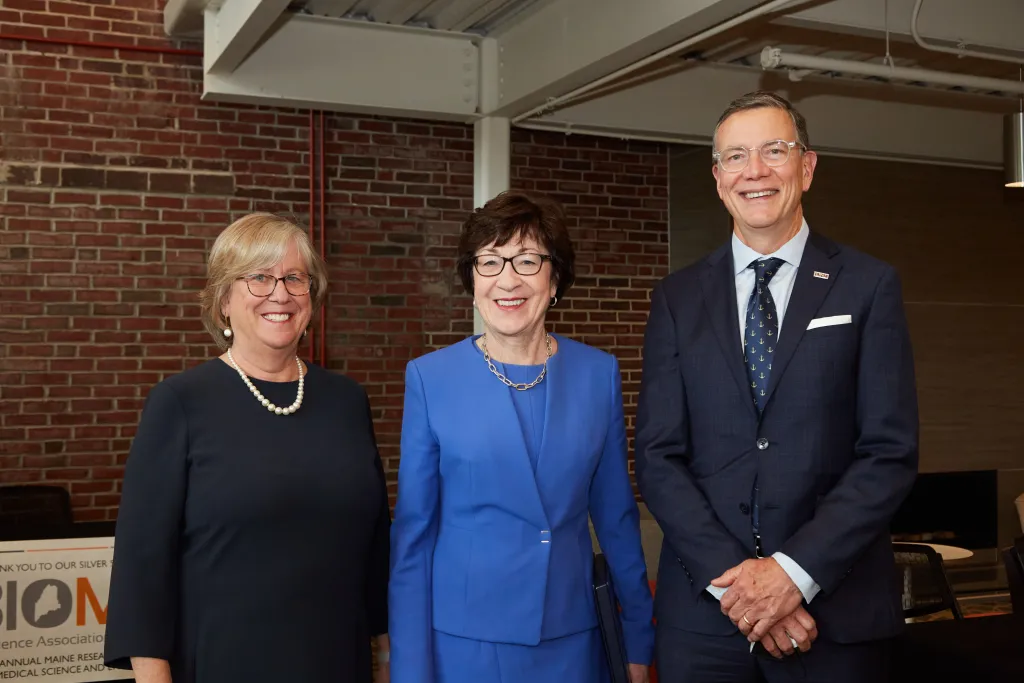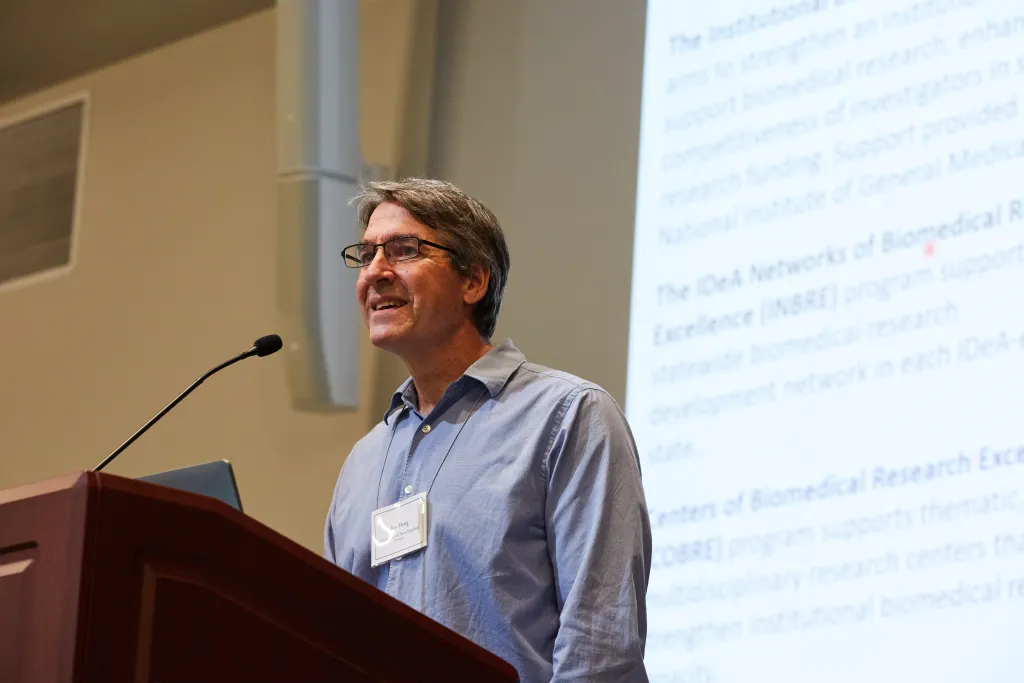UNE hosts first statewide symposium on biomedical research and engineering

The University of New England welcomed the state’s top biomedical researchers in a celebration of world-class research and innovation at the first annual Maine Research Symposium on Biomedical Science and Engineering, held Oct. 13 to 15 at the University’s Portland Campus.
The event — organized by the University of Maine Institute of Medicine in collaboration with UNE, the University of Southern Maine (USM), the Roux Institute, Jackson Laboratory, Mount Desert Island Biological Laboratory (MDIBL), MaineHealth, and Northern Light Health — was held in UNE’s Innovation Hall and drew more than 200 researchers in a showcase of Maine’s growing leadership in the increasingly important field.
“The biomedical industry has evolved, and our Maine institutions have developed to the point where we can realistically tackle many of the challenges that seemed insurmountable not long ago,” UNE President James D. Herbert, Ph.D., said in an address to the crowd. “And so, we convene, brought together by a shared commitment to building a healthier, stronger Maine, and, indeed, a healthier, stronger world through innovation in the biomedical sciences and engineering.
“UNE is committed to supporting and facilitating the research that makes biomedical breakthroughs possible,” Herbert continued. “As such, it is truly an honor for us to welcome so many individuals who are leading the way in this area.”
Among the symposium’s many highlights — including dozens of presentations related to research on public health and rural disparities, artificial intelligence, health care solutions, and innovations in biomedical technology — were remarks by U.S. Sen. Susan Collins, who earlier this year helped secure $5 million in federal funding for UNE’s relocation of the College of Osteopathic Medicine (UNE COM) to Portland.
“There simply is no investment we can make that provides greater returns for Americans than our investment in biomedical research,” Collins told the crowd. “It is not an exaggeration to say that biomedical research improves and changes lives and can change the world.”
The event was capped by a keynote address from Jon Lorsch, Ph.D., director of the National Institute of General Medical Sciences (NIGMS).
The NIGMS, a division of the National Institutes of Health (NIH), has been a significant investor in UNE’s researchers and research facilities, most recently on a $1.7 million grant to Diana Goode, Ph.D. professor of immunology in UNE COM, to study novel treatments for chemotherapy-related neuropathic pain, as well as $5 million to support the final phase of development of UNE’s Center of Biomedical Research Excellence (COBRE) for the Study of Pain and Sensory Function.
Karen Houseknecht, Ph.D., associate provost for Research and Scholarship at UNE, remarked that the symposium provided a dynamic, in-person celebration of research excellence among the faculty and students at Maine’s research institutions while highlighting ongoing, cross-institutional collaborations. She also said the event was key in building new relationships between the state’s in higher education, health care, biotechnology, and private research organizations.
“I was inspired to see the strength of the research and the passion of the scientists as they shared their work and vision for the future,” Houseknecht commented. “I am especially proud of the work presented by the student researchers, including medical, dental, pharmacy, and graduate students from UNE. We were all delighted to come together, in person, to share new ideas.”
Houseknecht said an important aspect of the event was to highlight the strengths of the NIH funded Maine INBRE program, the Northern New England Clinical and Translational Research Center, and COBRE centers across the state, including those at MaineHealth, MDIBL, and UNE.
“These important NIH investments in building biomedical research infrastructure in Maine have resulted in development of core research infrastructure, recruitment of research active faculty, training of students in research, as well as increased extramural grant funding in biomedical research in the state,” Houseknecht said.
Professor of physiology Tamara King, Ph.D., was one of several UNE researchers who presented at the symposium, showcasing her research, “Towards Understanding Sex Differences in Susceptibility to Develop Osteoarthritis Pain.” She said the venue — a panel discussion on COBRE collaborations between UNE and the MaineHealth Institute for Research — provided the opportunity to discuss cross-disciplinary work conducted in her lab.
“This was an amazing opportunity to highlight work examining mechanisms underlying chronic osteoarthritis pain done by my team,” King stated. “This demonstrates how the COBRE award to UNE fosters cutting-edge biomedical research, supports research opportunities for many students, and builds collaborations between COBRE centers at UNE and at the MaineHealth Institute for Research.”
Madison Mueth, a biomedical engineering Ph.D. student through the Graduate School of Biomedical Science and Engineering (GSBSE) — a multi-institutional research consortium that powers the state’s largest biomedical Ph.D. program — said it was intimidating, yet exciting, to present to such an esteemed audience.
“Presenting my work among Maine's top researchers was an invaluable opportunity for me,” reflected Mueth, who was awarded a prize for her presentation, “Sex differences in susceptibility to develop advanced osteoarthritis pain.” “The great thing about presenting at a symposium like this one is that there's such a strong sense of community among all the attendees; we're all rooting for each other to succeed,” she added. “I feel really proud to be part of this community and to learn from my friends and colleagues as they progress in their research.”
Vrushabh Daga (D.O., ’25), also a prized poster presenter, echoed Mueth’s sentiment.
“It was a great opportunity to be in the same room as some of the best and brightest in the state,” he said. “Conferences like this are what stimulate the intellectual minds of students and advance science. I am looking forward to more such opportunities in the future.”



